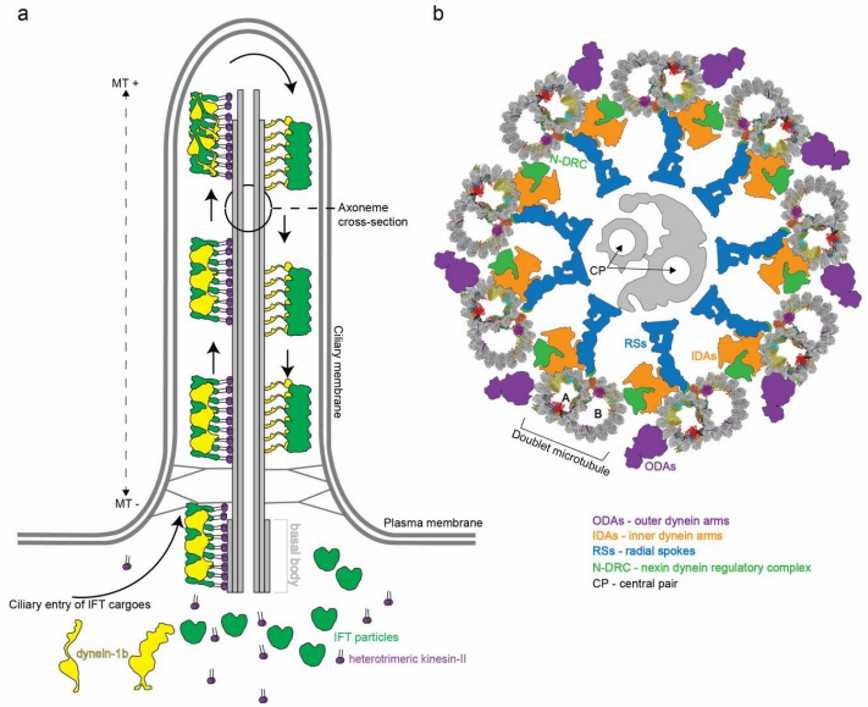Green Algae as a Model Organism
There are approximately 22,000 species of green algae worldwide, including both unicellular and community flagellates. Many species live most of their lives as unicellular forms, whereas others form coenobia (colonies), long filaments, or highly differentiated macroscopic algae. Diverse species of green algae are applied as model organisms in different fields of scientific research.
Chlamydomonas reinhardtii, a Classical Model Organism
Chlamydomonas reinhardtii is one of the single-celled green algae, about 10 microns in diameter. Chlamydomonas reinhardtii has two pre-flagellae, 10-12 µm in length, showing a typical 9+2 microtubule structure from a pair of basal bodies. Chlamydomonas species are widely distributed in soil and freshwater around the world.
 Advantages of Chlamydomonas reinhardtii as a Model Organism
Advantages of Chlamydomonas reinhardtii as a Model Organism
Chlamydomonas reinhardtii is a particularly well-studied biological model organism, in part because of its ease of culture and ability to manipulate its genetics. Under normal conditions, vegetative cells are haploid and grow quickly, with a mean doubling time of 6-8 hours under optimal conditions. In the laboratory, vegetative diploids can be easily produced and maintained.
 Available Genomic Resources of Chlamydomonas reinhardtii
Available Genomic Resources of Chlamydomonas reinhardtii
The assembled nuclear genome, the complete about 15.8 Kb mitochondrial genome, and the complete about 203.8 Kb chloroplast genome of Chlamydomonas reinhardtii are available online. In addition, many molecular tools have now been developed to facilitate the study of the mechanisms of physiological activity of green algae.
Diverse Research Areas
A wide variety of green algae are used as model organisms in different scientific research scenarios.
 Biological Fluid Dynamics
Biological Fluid Dynamics
Over the past decade, green algae have become model organisms for many problems in biofluid dynamics, from the single-celled Chlamydomonas to the multicellular Volvox. These studies have included flagellar propulsion, nutrient uptake by swimming organisms, wall-mediated hydrodynamic interactions, collective dynamics, and transport within micro-swimming suspensions, mechanisms of phototaxis, and stochastic dynamics of flagellar synchronization. Green algae are well suited to study these topics because of their size range, from 10 microns to a few millimeters, their geometric regularity, the fact that they can be easily cultured, and the fact that there are many mutants that can make connections between molecular details and organism-level behavior.
 Fig.1 Schematic representation of a cilium from Chlamydomonas reinhardtii. (Petriman, N. A., & Lorentzen, E., 2020, Microbial Cell)
Fig.1 Schematic representation of a cilium from Chlamydomonas reinhardtii. (Petriman, N. A., & Lorentzen, E., 2020, Microbial Cell)
 The Evolution of Multicellularity
The Evolution of Multicellularity
The evolution of multicellularity is divided into the main aspects of multicellular evolution, cell differentiation, and multicellular development. Because green algae have assumed multiple independent evolutions of multicellularity and have evolved a wide variety of multicellular and giant unicellular forms with widely varying morphology, life cycles, and development, they are ideal model organisms for studying multicellular evolution.
 Other Areas of Research
Other Areas of Research
Green algae also have important applications as model organisms in many other areas. For example, the macroalga Ulva mutabilis is used to study the symbiosis between related macroalgae and bacteria, Chlamydomonas reinhardtii is used to study the molecular mechanisms of efficient light energy capture and transfer in photosystem I, the multicellular green alga Volvox carteri is used to study the mitotic characteristics of cells, and a variety of green algae are used to study the regulation and molecular mechanisms of intracellular metabolic pathways.
Our Services
With top-notched precision platforms and experienced scientists, Lifeasible can offer cost-effective and high-quality algae isolation and culture services, algae engineering services, algae analysis services, algae genetic screening services, algae-based production services, algae monitoring services, algae treatment services, and algae-based biosensor services for environmental monitoring. Please contact us for more information.
Reference
- Petriman, N. A., & Lorentzen, E. (2020). Structural insights into the architecture and assembly of eukaryotic flagella. Microbial Cell, 7(11), 289.
Our services are for research use only and not for any clinical use.